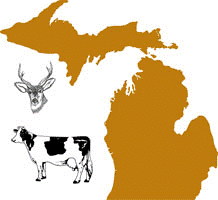Wildlife Disease and Zoonotics
Date of this Version
2007
Abstract
Mycobacterium bovis, the causative agent of bovine tuberculosis (bTB), is endemic in free-ranging white-tailed deer (Odocoileus virginianus) in 5 counties (Alcona, Alpena, Montmorency, Oscoda, and Presque Isle) in the northeastern Lower Peninsula of Michigan, USA. The presence of a wildlife reservoir of tuberculosis in Michigan and the incidence of bTB in cattle (Bos taurus) resulted in Michigan losing its bTB accredited-free status. Subsequent wildlife surveillance programs identified relatively high disease prevalence in coyotes (Canis latrans), generating interest in their potential to serve as a sentinel species to detect bTB prevalence in white-tailed deer. Our goal was to develop an empirical basis for generating hypotheses about the spatial epidemiology of bTB infection in coyotes for future surveillance, management, and modeling efforts. Though variation in coyote home-range size may confound attempts to spatially correlate the incidence of disease in the sentinel and host species at a fine scale, overlap zones (OZs) between adjacent coyote home ranges may be the appropriate sample unit for spatially correlating disease prevalence in coyotes and white-tailed deer. Because overlapping home ranges are generally configured around resource rich (e.g., small mammals and white-tailed deer) timber management patches, the OZ concentrates spatial interaction between adjacent groups in a relatively small area. Furthermore, there is a direct relationship between interaction probabilities and the spatial dispersion of those patches. The latter finding provides a useful metric to incorporate into future efforts to develop spatially explicit models of bTB dynamics. Modeling efforts can then be used as a foundation to predict the epidemiological ramifications of alterations in intensively managed forested landscapes.



Comments
Published in JOURNAL OF WILDLIFE MANAGEMENT 71(5):1545–1554; 2007).